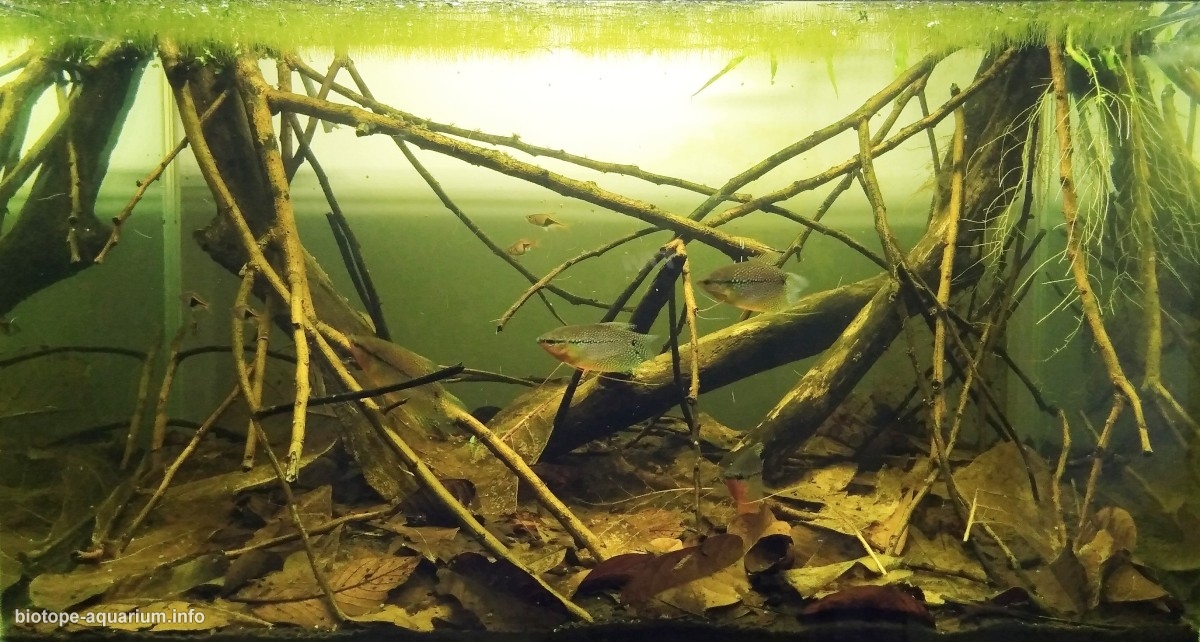Shallow Peat swamp near Tanjung Malim, Perak, Malaysia
99th place in Biotope Aquarium Design Contest 2019
Malaysia. Amir Hazwan Saad

Volume: 126 L
Dimensions: 75x40x40 cm
List of fishes: Pearl Gourami (Trichopodus leerii), Harlequin rasbora (Trigonostigma heteromorpha)
List of plants: Algae (unknown species), Dead leaves (Macaranga sp. and Catappa sp.).
Description of decorations: The floor was similar type of soil with half decomposed bog woods, new dead branches and Catappa and Macaranga leaves. The colour of the water are very similar to those found in the nature biotope due to tannin provided by the dead leaves.
Description of equipment: Filter: Ejet 3368
Light: Chihiros A601
Water parameters: Temperature is 28°C, pH is 5.8, kH 3 and GH 4.
Additional info: 30% weekly water changes. Adding dried catappa and macaranga leaves once the old one started to decompose.
INFORMATION ABOUT BIOTOPE
Description of the area surrounding the biotope: This aquarium was set up based on the shallow peat swamp near Tanjung Malim, Perak, Malaysia. Malaysia’s peat swamps not only contain unique ecosystems that accommodate many endemic species but also provide sanctuary for viable populations. The water is typically stained darkly with humic acids and other chemicals released by decaying organic materials that formed when plant material is inhibited from decaying fully by the acidic conditions and an absence of microbial activity. In unaltered habitats, the dense canopy of branches above provide very little light penetrates the surface of such environments, and riparian vegetation also tends to grow thickly.
Description of the underwater landscape of the biotope: The black water swamp are waterlogged forests growing on a layer of dead leaves and plant material up to 20 meter thick. The swamps are maintained either by direct rainfall or by groundwater, which common in tropical regions with high rainfall like Malaysia. This produce slow-moving, well-shaded and shallow water (about 3 meter deep) habitats. The floor contains lots of bog woods and leaves, half decomposed.
Description of the parameters of the habitat: Habitats is highly acidic tea-coloured water of between pH 3.5 to 6. Well shaded shallow waters, which temperature range between 22°C to 28°C. Water hardness below 50 ppm and conductivity about 145 mV.
List of fishes and invertebrates occurring in the nature biotope: Chocolate Gourami (Sphaerichthys osphromenoides), ‘Pentazona’ Barb (Desmopuntius hexazona), Harlequin (Trigonostigma heteromorpha), Glowlight Rasbora (Trigonopoma pauciperforatum), Licorice Gourami (Parosphromenus harveyi), Giant Pikehead (Luciocephalus pulcher), Leaffish (Nandus nebulosus), Dwarf Rasbora (Boraras maculatus), Betta Livida, Brilliant Rasbora (Rasbora einthovenii), Pearl Gourami (Trichopodus leerii), Bangka Snakehead (Channa bankanensis), Croaking Gourami (Trichopsis vittata).
List of plants found in the nature biotope: Cryptocoryne minima, Blyxa (auberti, japonica), Barclaya motleyi, Eleocharis sp., Utricularia gibba, Limnophila sessiliflora, Nepenthes mirabilis, Pandanus amaryllifolius and Lemna minor. Land vegetation near the swamp like Macarange sp. trees.
Threats to the ecology: The aquarium was set up to attract international attention to the problem of rapid reduction of peat swamp forest, particularly in Peninsular Malaysia.
Nearly 60 per cent of Malaysia, or about 19.5 million hectares, is under forest cover of one type or another. Peat swamp forests constitute a significant component of this cover with an estimated 1.54 million hectares still remaining. More than 70 per cent of these peat swamp forests are in Sarawak, less than 20 per cent in Peninsular Malaysia and the remainder in Sabah. Large areas of peat swamp forest in Malaysia have already been cleared and drained for agriculture, settlement and other human activities, but such changes completely alter the landscapes and eliminate many of the specialized flora and fauna associated with these wetlands.
Conserving the forests is crucial not only to ensure sustainable and protection of endangered species, but also to maintain environmental stability.
Sources of information: Books:
“Malaysia’s Conservation and Sustainable Use Peat Swamp Forests” published by the United Nations Development Programme (UNDP), Malaysia.
“Cryptocoryne of Peninsular Malaysia” published by Penerbit Universiti Sains Malaysia.
Articles:
https://blogs.helsinki.fi/
https://news.mongabay.com/
http://www.my.undp.org/
https://www.seriouslyfish.com/
https://www.seriouslyfish.com/
